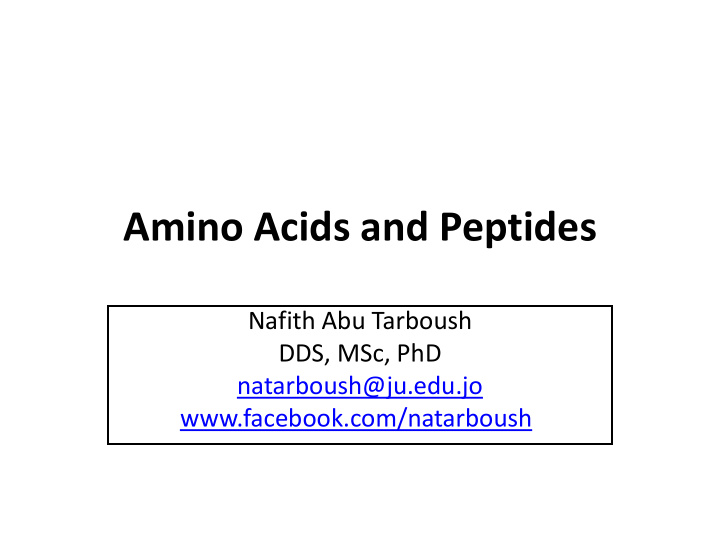



Amino Acids and Peptides Nafith Abu Tarboush DDS, MSc, PhD natarboush@ju.edu.jo www.facebook.com/natarboush
Protein structure and function • Greek: proteios, primary (importance) • 50 % of body’s dry weight is protein • Wide range of different functions • Polymers of amino acids • Structure of the amino acids
What should not be forgotten for good? • There are a lot of amino acids in life. • There are 20 encoded by the genetic code. • Their general structure(amino, carboxyl, H, R), the basis of their classification. • Two vs. 3-dimentional (handedness, chirality, chiral vs. achiral, left vs. right, L vs. D).
Names and codes Amino Acid 3-letter 1-letter Amino Acid 3-letter 1-letter code code code code Alanine Ala A Leucine Leu L Arginine Arg R Lysine Lys K Asparagine Asn N Methionine Met M Aspartic acid Asp D Phenylalanine Phe F Cysteine Cys C Proline Pro P Glutamic acid Glu E Serine Ser S Glutamine Gln Q Threonine Thr T Glycine Gly G Tryptophan Trp W Histidine His H Tyrosine Tyr Y Isoleucine Ile I Valine Val V
Charged
Polar, Uncharged ( — S — S — )
Non-polar, Uncharged imino acid
Posttranslational modification of Amino Acids
Titration of amino acids: what happens? And what is an isoelecrtic point (pI)? pI =(p Ka 1 + pKa 2 )/ 2
The peptide bond, peptides, and proteins
Amino Acids & life
Amino acids & life • Two amino acids deserve special attention ( Tyr & Trp ) with respect to neurotransmission. • Tryptophan converted to 5- hydroxytryptamine ( serotonin , sedative effect). • Very low levels are associated with depression, while extremely high levels produce manic state. • Tryptophan, milk and sleep
Amino acids & life • The active products of Tyr metabolism are monoamine derivatives (MA). MAOs . • Headaches and Phe in aspartame. • Phe, Tyr, catecholamines; epinephrine (adrenalin) . MAO i makes metabolism slow. • A Beautiful Mind, focused on Dopamine . • Tyrosine supplements & morning lift. • Cheese and red wines (tyramine; mimics epinephrine); a cheese omelet is a favorite way to start the day.
Other amino acids • Glutamic Acid: Monosodium glutamate, or MSG, a flavor enhancer. MSG causes a physiological reaction in some people, with chills, headaches, and dizziness resulting in ( Chinese restaurant syndrome) • Histidine: converted to histamine, a potent vasodilator, part of the immune response, results in swelling and stuffiness that are associated with cold. Most cold medications contain antihistamines to overcome this stuffiness.
Aspartame, the Sweet Peptide • L-aspartyl-L-phenylalanine, commercial importance • The methyl ester derivative is called aspartame • 200 times sweeter than sugar
Phenylketonuria • Inborn errors of metabolism; errors in enzymes of amino acids metabolism • May have disastrous consequences (mental retardation). • Phenylketonuria (PKU) is a well-known example. • PKU can be easily detected and managed in newborns • Aspartame carry a warning • Alatame (Ala instead of Phe) is a substituent
Small Peptides with Physiological Activity • Carnosine (dipeptide), found in muscle tissue, ( β -alanyl-L-histidine), anti- oxidant, chelation of heavy metals • Glutathione (tripeptide; g-glutamyl-L- cysteinylglycine); a scavenger for oxidizing agents.
Small Peptides with Physiological Activity • Enkephalins (pentapeptides), naturally occurring analgesics. Tyr — Gly — Gly — Phe — Leu (Leucine enkephalin) Tyr — Gly — Gly — Phe — Met (Methionine enkephalin) • Similarities of three-dimensional structures to opiates (e.x, morphine) • Some important peptides have cyclic structures. Two well- known examples, oxytocin and vasopressin
Peptide Hormones-Small Molecules with Big Effects Vasopressin stimulates reabsorption of water by the kidney, thus having an antidiuretic effect
Recommend
More recommend